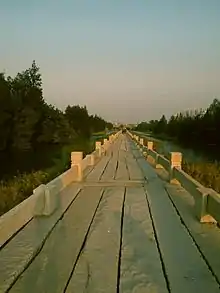Anping Bridge
Anping Bridge (simplified Chinese: 安平桥; traditional Chinese: 安平橋; pinyin: Ānpíng Qiáo; Pe̍h-ōe-jī: An-pêng Kiô) is a Song dynasty stone beam bridge in Fujian province. It is 2,070 metres (1.29 mi) long.[1][2] The bridge is also known as the Wuli Bridge (simplified Chinese: 五里桥; traditional Chinese: 五里橋; pinyin: Wǔ Lǐ Qiáo, literally Five Li Bridge) because its length is about 5 li, where a li is about 500 meters or 0.3 miles.[3] It is a nationally protected historic site registered with the National Cultural Heritage Administration.
Anping Bridge 安平桥 | |
|---|---|
 Anping Bridge, with Anhai Town in the far background | |
| Coordinates | 24°42′27″N 118°26′56″E |
| Crosses | Shijing River |
| Locale | Quanzhou, Fujian, China |
| Characteristics | |
| Design | Beam bridge |
| Material | Stone |
| Total length | 2,070 metres (6,790 ft) |
| Width | 3 to 3.8 metres (9.8 to 12.5 ft) |
| No. of spans | 331 |
| History | |
| Construction start | 1138 |
| Construction end | 1151 |
| Location | |

| |
The bridge lies in the prefecture-level city of Quanzhou, crossing what originally was a tidal estuary of the Shijing River that separates the town of Anhai (in the county-level city of Jinjiang) east of the river, from the town of Shuitou (in the county-level city of Nan'an) west of the river. The bridge is named after Anhai, which was formerly known as Anping.[3]
Anping Bridge consists of 331 spans of granite beams resting on top of stone piers,[2][3] the largest beam weighing 25 tons. The width of the bridge varies from 3 to 3.8 metres (9.8 to 12.5 ft). It originally had five pavilions where travelers could rest; however, only one pavilion (Shuixin Pavilion) still exists.[3]
History
Construction of the bridge started in 1138 during the Southern Song dynasty and lasted until 1151. It was originally 811 zhang [2,223 metres (1.381 mi)] long and 1.6 zhang [4.4 metres (14 ft)] wide,[3] with 362 spans.[4] Upon completion, it was the longest bridge in China until 1905,[3] inspiring the local description, "No bridge in the world is as long as this one" (simplified Chinese: 天下无桥长此桥; traditional Chinese: 天下無橋長此橋).[2] There have been six major repairs since its opening, and the bridge is now shorter due to silting of the estuary.[1]
Current conditions
The estuary of the Shijing River has mostly silted up in this area, and the remaining river channel under the bridge is fairly narrow. Consequently, the bridge now mostly crosses what amounts to a sequence of lakes or ponds, separated by wetlands. A modern public highway crosses the Shijing River a few hundred meters south (downstream) of the historical Anping Bridge over a fairly short bridge. The areas around the bridge are being developed into parks.[5][6]
Gallery
- Anping Bridge
 The bridge's main roadway passes by Shuixin Pavilion
The bridge's main roadway passes by Shuixin Pavilion Western section of the bridge, with Shuitou Town in the background
Western section of the bridge, with Shuitou Town in the background Looking west along the bridge from Shuixin Pavilion
Looking west along the bridge from Shuixin Pavilion
| Wikimedia Commons has media related to Anping Bridge. |
Notes
- Fu et al (2002), p. 185
- Mao (1978), p. 6
- Ministry of Culture of the People's Republic of China (2003)
- Tongji University (2000)
- 安平桥西侧将成生态湿地公园 可登塔看夕照 [West Side of Anping Bridge Will Become Ecological Wetland Park, Can See Plethora of Sunsets]. Dongnan Morning News (in Chinese). Quanzhou Web. June 8, 2010. Archived from the original on June 18, 2012. Retrieved January 1, 2014.
- 泉州晋江安海启动旧城改造 3月底将开始动迁 [Anhai to Start Renewal of Old Town, Relocations Begin at End of March]. Quanzhou Web (in Chinese). January 25, 2011. Archived from the original on March 3, 2016. Retrieved January 1, 2014.
References
- Fu Xinian; Guo Daiheng; Liu Xujie; Pan Guxi; Qiao Yun; Sun Dazhang (December 2002). Steinhardt, Nancy (ed.). Chinese Architecture. Yale University Press. ISBN 0-300-09559-7.
- Mao Yi-sheng (1978). Bridges in China, Old and New: From the Ancient Chaochow Bridge to the Modern Nanking Bridge over the Yangtze. Peking: Foreign Languages Press.
- Ministry of Culture of the People's Republic of China (2003). "Anping Bridge (Five Li Bridge)". ChinaCulture.org. Archived from the original on 2012-03-21.
- Tongji University, Bridge Engineering Department (2000). "Ancient Bridges in China". Bridges in China. Archived from the original on July 7, 2011.